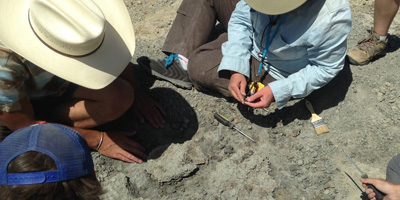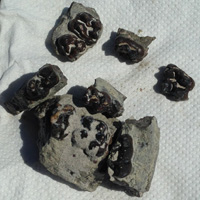by Kimberly Nichols
Working in fossil beds dating to 56-53 mya in the Bighorn Basin in Wyoming, the 2016 Colorado State University (CSU) Paleontology Field School crew, with the addition of visitors from the CSU Department of Anthropology, Dr. Joe Sertich of the Denver Museum of Nature & Science, and former Paleontology Field School students Lindsey Johnson and Andrew Lake, recovered over 640 catalogued fossil specimens – a new field season record!

Fossil Finds

These fossils included numerous exceptional finds, such as: the earliest true primates (tarsier-like Teilhardina & Tetonius; lemur-like Cantius) and their close relatives, the plesiadapiforms (Phenacolemur, Microsyops, Niptomomys); a partial skeleton of the earliest-known horse (Hyracotherium, formerly known as Eohippus); cranial and dental remains of an individual of the otter-like Palaeosinopa; the rarely associated upper and lower jaws of the probable elephant-shrew (Haplomylus); a nearly complete mandible of the mouse-deer-like Diacodexis, and so much more!


All of the specimens are now in the process of preparation in the Paleontology Field School Lab at CSU where they are being catalogued into the Denver Museum of Nature & Science Vertebrate Paleontology collection. The specimens are on semi-permanent loan for supervised CSU undergraduate research.
Undergraduate Research
Undergraduate research projects in the lab resulted in two Celebrate Undergraduate Research and Creativity (CURC) presentations last Spring, Kaia Renouf’s research on Coryphodon interspecies and intraspecies variation, and Ben Rodwell’s award winning research on the relationships between paleosol maturity, faunal distribution, and microhabitat formation. Research from the lab has resulted in multiple abstract publications and presentations at professional scientific meetings. For example, Ben Rodwell will elaborate further on his studies at the upcoming Geological Society of America 2016 annual meeting in Denver.


New undergraduate research projects on nine taxa have been initiated by this year’s field crew! The results of these projects will be reported in Anthropology Capstone, Honors Capstone, and/or Spring 2017 CURC presentation events! Emily Yannarella is examining the evolution of early elephant shrews, Rachel Bockrath is studying crocodilian systematics, Courtney Patton is obtaining data on primate intraspecies and interspecies body mass and dental trait variation, Lindsey Johnson is employing stable isotope analysis to determine environmental and seasonal characteristics in early horses, Jules Kateley is documenting dental variation in perissodactyls relative to stratigraphic location, and Hannah Curtis is obtaining data on plesiadapiform body mass variation.
The primary goal of all research produced in the Paleontology Field School Lab is to elucidate an understanding of the early Eocene biome in which early primates arose and diversified.